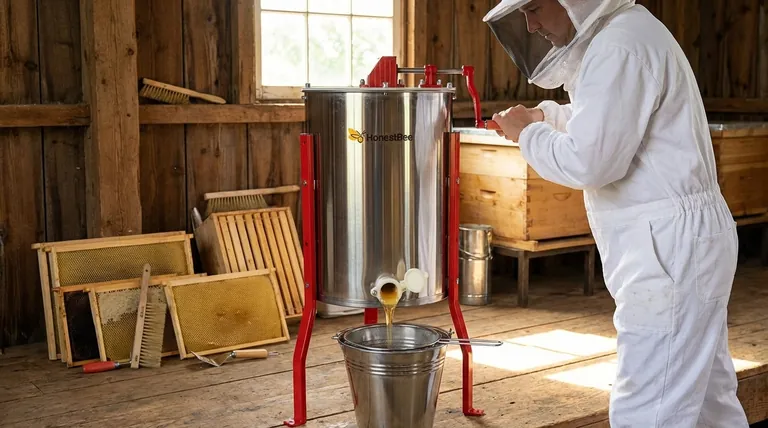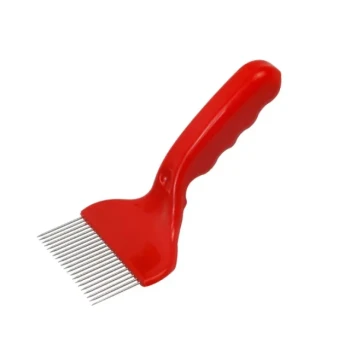To use a honey extractor, you place uncapped honey frames into the machine's baskets, spin them to sling the honey out via centrifugal force, and then collect the honey from a spigot at the bottom. This mechanical process is the final, rewarding step that separates pure honey from the beeswax comb, allowing you to harvest it without destroying the frame.
Successful honey extraction is a complete workflow, not just a single action. It requires careful preparation of the frames, balanced operation of the extractor, and diligent cleanup to ensure a high-quality product and the continued health of your hive.

The Extraction Workflow: From Hive to Harvest
The process begins before you even touch the extractor and continues after the last drop of honey is collected. Each step is critical for a smooth, efficient harvest.
Step 1: Preparing Your Frames
Before extraction, you must get the frames ready. First, bring the frames indoors from the hive, gently brushing off any lingering bees with a bee brush.
The most crucial preparation step is uncapping. Bees seal their honey-filled cells with a layer of beeswax. You must remove these "cappings" using a specialized hot knife, uncapping fork, or roller to expose the liquid honey within.
Step 2: Loading the Extractor
Properly loading the extractor is essential for preventing damage to the machine and your frames. Place the uncapped frames vertically into the baskets or slots.
The single most important rule is to balance the load. Place frames of similar weight directly opposite each other, much like balancing a load of laundry in a washing machine. An unbalanced extractor will shake violently, potentially damaging the bearings or the machine itself.
Step 3: The Spinning Process
Once loaded, you begin spinning the frames. This can be done with a manual hand crank or an electric motor.
As the extractor spins, it generates centrifugal force. This force pulls the honey outwards from the comb, causing it to hit the inner wall of the extractor drum. Gravity then pulls the honey down to the sloped floor of the tank.
Step 4: Collecting the Honey
At the bottom of the extractor is a valve known as a honey gate or spigot. Once a sufficient amount of honey has collected, open the gate to let it flow out.
Position a clean, food-grade bucket under the gate to collect the honey. It's common practice to place a fine mesh strainer or filter over the bucket to catch any stray bits of beeswax or debris before bottling.
Tangential vs. Radial: A Key Distinction
Not all extractors work the same way. The two primary types, tangential and radial, have different methods of operation that impact efficiency.
Tangential Extractors
In a tangential extractor, the frames are placed with one side of the comb facing outward. The machine spins and extracts honey from that one side only.
You must then stop the extractor, manually flip each frame so the other side faces out, and spin it again. These are common for smaller, hobbyist operations.
Radial Extractors
In a radial extractor, frames are loaded like spokes on a wheel, with the top bar of the frame facing outward.
Centrifugal force extracts honey from both sides of the frame simultaneously, making them significantly faster and more efficient. This design is the standard for commercial and serious sideline beekeepers.
Understanding the Common Pitfalls
Avoiding a few common mistakes will protect your equipment, your honey, and your bees.
The Risk of an Unbalanced Load
An imbalanced extractor can shake so violently it "walks" across the floor, stressing the internal components and risking breakage. Always take the time to balance the frames by weight.
The Danger to Fragile Combs
Never extract honey from combs that lack internal support, such as frames without wire or plastic foundation. The intense force of the spin will cause these natural combs to blow apart, creating a major mess and destroying the comb your bees worked so hard to build.
The Importance of Sanitation
After you finish, the extractor must be thoroughly cleaned with hot water. Leftover honey can ferment and attract pests, while old wax and debris can harbor diseases that could be spread back to your hives the next time you use the equipment.
How to Apply This to Your Harvest
Your approach will depend on the scale of your operation and your primary goals.
- If your primary focus is a small-scale hobby harvest: A manual tangential extractor is a cost-effective and perfectly suitable choice for a few hives.
- If your primary focus is efficiency and larger harvests: An electric radial extractor is a necessary investment that will save you significant time and labor.
- If your primary focus is hive health and honey quality: Meticulous cleaning of your extractor after every use is your most critical task, preventing disease and ensuring purity.
Mastering the extractor is a key step in transforming your hard work as a beekeeper into a pure, delicious harvest.
Summary Table:
| Step | Key Action | Critical Tip |
|---|---|---|
| 1. Preparation | Uncap honey frames | Use a hot knife or uncapping fork |
| 2. Loading | Place frames in extractor | Balance the load to prevent damage |
| 3. Spinning | Spin frames via hand crank or motor | Centrifugal force extracts the honey |
| 4. Collection | Open honey gate into a bucket | Use a strainer to filter debris |
Ready to upgrade your harvest?
Whether you're a commercial apiary focused on efficiency or a distributor stocking quality equipment, the right extractor is key to your success. HONESTBEE supplies durable, high-performance honey extractors—from manual tangential models for smaller operations to electric radial extractors for large-scale harvests—designed to save you time and protect your honey's quality.
Contact our experts today to find the perfect extraction solution for your business and ensure a bountiful, high-quality harvest season after season.
Visual Guide

Related Products
- 2 Frame Stainless Steel Manual Honey Spinner Extractor for Beekeeping
- 6 Frame Manual Stainless Steel Honey Extractor Beekeeping Equipment
- HONESTBEE 72 Frame Industrial Electric Honey Extractor for Beekeeping
- electric honey extractor honey centrifuge 3 frame honey extractor stainless steel honey frame extractor
- Plastic Hand Crank 2 Frame Honey Extractor Low Price
People Also Ask
- How do beekeepers harvest honey from the honey super? A Step-by-Step Guide to Efficient Extraction
- How often should a honey extractor be cleaned if used multiple times a year? Optimize Your Harvest Workflow
- What are some tips for using a honey extractor effectively? Maximize Your Honey Yield and Protect Your Comb
- Can a manual extractor be upgraded to an electric one? Save Labor & Boost Efficiency
- What are the consequences of leaving honey in an extractor? Protect Your Honey Quality and Equipment



















